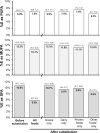Assessing the impact of replacing foods high in saturated fats with foods high in unsaturated fats on dietary fat intake among Canadians
- PMID: 34958344
- PMCID: PMC8895210
- DOI: 10.1093/ajcn/nqab420
Assessing the impact of replacing foods high in saturated fats with foods high in unsaturated fats on dietary fat intake among Canadians
Abstract
Background: The 2019 Canada's Food Guide (CFG) recommends that foods containing mostly unsaturated fatty acid (UFA) should replace foods that contain mostly SFA to reduce SFA intakes.
Objectives: The objective of this study was to model the theoretical changes in intake of SFA at the population level if all Canadians adhered to that recommendation.
Methods: Dietary intakes from 24-h recalls in the nationally representative 2015 Canadian Community Health Survey-Nutrition were used for these analyses. Foods identified as high in SFA based on Health Canada's criteria [≥2 g SFA per reference amount and/or ≥15% of energy (%E) of the food's content as SFA] were replaced by an equal amount (gram per gram) of substitution foods that were lower in SFA and had a higher UFA to SFA ratio. Distributions of SFA and other nutrients before and after substitutions were estimated using the National Cancer Institute (NCI) method based on dietary intakes data from a 24-h recall repeated in 37% of the population.
Results: The mean (95% CI) dietary SFA intake among Canadians 2 y or older would be theoretically reduced from 10.8%E (10.7, 11.0%E) to 5.8%E (5.7, 5.9%E) if all high-SFA foods consumed were replaced by the corresponding low-SFA/high-UFA foods. Modeled usual intake of SFA after substitution was <10%E in 100% of Canadians, irrespective of sex and age. Almost half (44%) of the modeled reduction in SFA intake was attributed to replacement of SFA-rich foods not recommended in the 2019 CFG.
Conclusions: This food-based substitution modeling analysis suggests that consumption of SFA would be below 10%E in Canada if all Canadians adhered to the 2019 CFG recommendation that foods containing mostly UFA should replace foods that contain mostly SFA.
Keywords: 2015 Canadian Community Health Survey (CCHS)–Nutrition; Canada's Food Guide (CFG); dietary guidelines; saturated fats; substitution; unsaturated fats.
© The Author(s) 2021. Published by Oxford University Press on behalf of the American Society for Nutrition.
Figures


References
-
- Harrison S, Brassard D, Garriguet D, Lemieux S, Lamarche B. A food-level substitution analysis assessing the impact of replacing regular-fat dairy with lower fat dairy on saturated fat intake at a population level in Canada. Am J Clin Nutr. 2021;114(5):1830–6.. doi:10.1093/ajcn/nqab251. - PubMed
-
- World Health Organization . Draft guidelines on saturated fatty acid and trans-fatty acid intake for adults and children. Public Consultation May to June 2018. Geneva (Switzerland): World Health Organization; 2018. 1–103.
-
- Health Canada . Canada's dietary guidelines for health professionals and policy makers. Canada: Health Canada; 2019. 1–57.. https://food-guide.canada.ca/en/guidelines/.
-
- Food and Agriculture Organization of the United Nations . Fats and fatty acids in human nutrition. Report of an expert consultation. FAO Food and Nutrition Paper. 2010;91:1–166. - PubMed
Publication types
MeSH terms
Substances
Grants and funding
LinkOut - more resources
Full Text Sources

